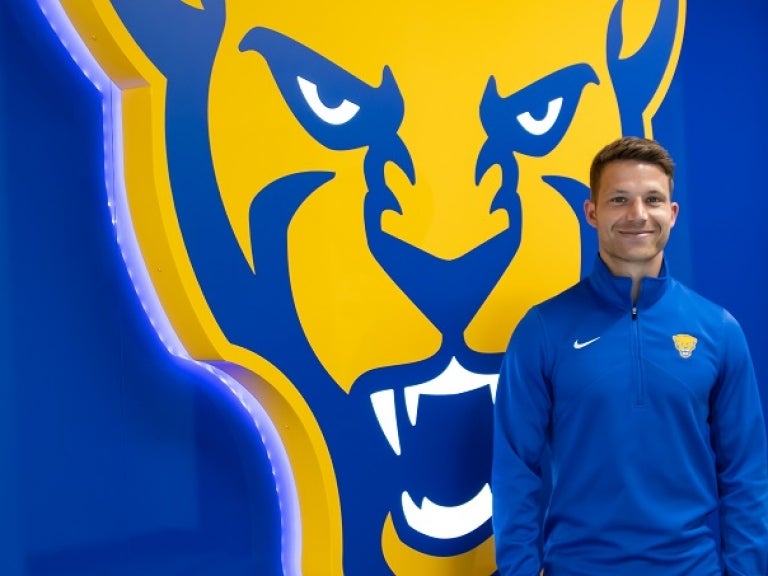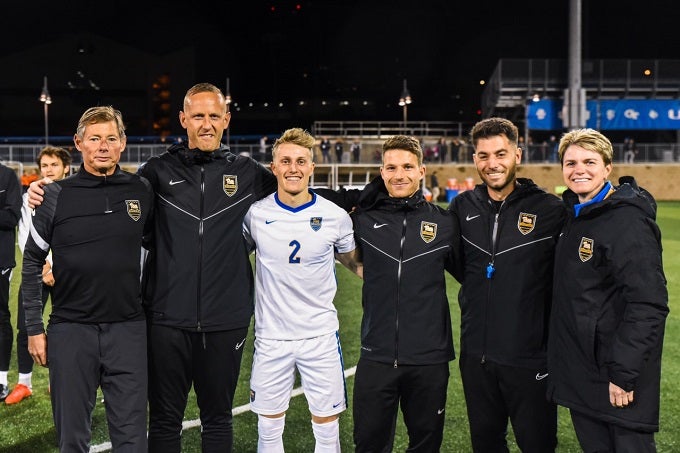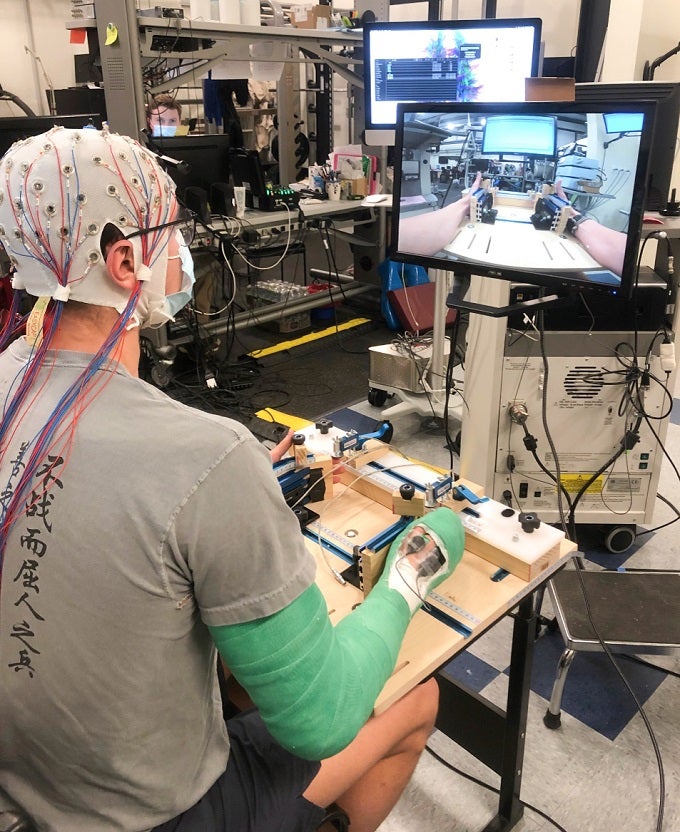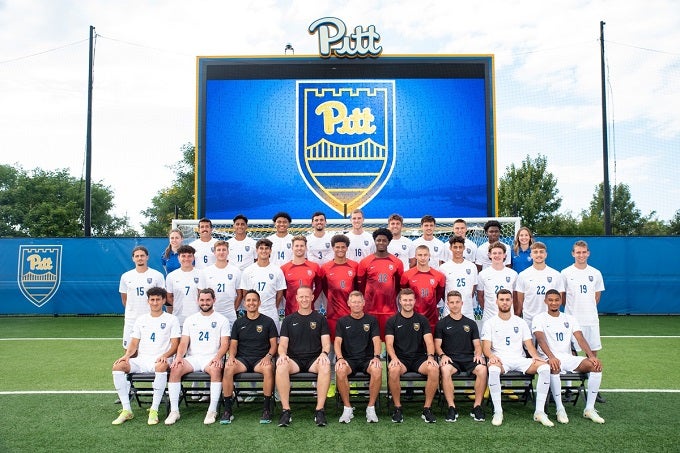
Felix Proessl, SHRS Alumnus and New Pitt Athletics Director of Sports Science
Drive and passion. The University of Pittsburgh has become a nexus for students who live by these traits to fulfill their academic and professional goals. Felix Proessl, 2022 graduate of the Rehabilitation Science PhD program, is the embodiment of drive and passion and the success they can lead to. They have taken him from the small town of Weiden in southeast Germany where he grew up, to the wide-open ranges of Nebraska and Colorado, and finally to the research and sports haven of Pittsburgh where he is pushing the boundaries of athletic performance as the new Director of Sports Science at Pitt Athletics.
In this three-part series, Proessl discusses his academic journey forging his own path in applied sports science where none previously existed–until now. The “one-of-a-kind” Pitt Master’s of Sports Science program in the School of Health and Rehabilitation Sciences (SHRS) offers what Proessl was driven to design on his own throughout his academic career: volunteering for sports teams to apply what he was learning in the classroom, and aligning himself with coaches and staff who needed someone with expertise in the most current research and technology to improve their athletes’ performance.
Now as a Pitt alumnus and working for one of the top collegiate sports programs in the U.S., Proessl is eager to continue Pitt’s legacy of supporting both its student athletes and its up-and-coming sports scientists, just as the faculty and staff empowered him to discover his full potential. This experience is one that students continually praise about Pitt: that the community fully supports their goals and will pave the way for transformative opportunities, ones that have become the foundation of Panther Nation.
Charting His Own Path in America
Proessl came to the U.S. from Germany in 2012 when he was recruited to play soccer at Hastings College in Nebraska. As an undergraduate student-athlete, he began studying exercise science and became more curious about maximizing his own soccer performance. “I was my own experiment, day in and day out. I was tactically gifted in soccer, but clearly lacked the athleticism compared to my American teammates. Because of this, I was constantly trying to be 100% ready for training, asking ‘How do I maximize my own performance?’”
Proessl was endlessly curious about the role that the central nervous system played in cognitive decision-making. “There’s the physical side of soccer, but also a cognitive component. For example, you need to find your open teammate among many opponents when pressure is high and pass the ball at the right time with the appropriate amount of weight.” He would watch replays of himself during games, growing progressively more fatigued and making mistakes that he wouldn’t do when he was fresh. This connection drove him to learn more about the brain’s role in optimizing athletic performance and to continually seek out opportunities to surround himself with the best in the field of neurophysiology.
At Colorado State University, he pursued a master’s degree in health and exercise science that included working as a graduate research assistant under the mentorship of Dr. Thorsten Rudroff in the Integrative Neurophysiology Lab. The position was purely research-driven and explored the functional deficits in individuals with neurological disorders, such as Multiple Sclerosis, and whether brain stimulation could counteract these performance decrements. After a year in the lab, his gut told him something wasn’t right. While he saw the utility in the research and was intrigued by its application to sports, he needed to return to the playing field, applying what he was learning to the athletes. He volunteered with the women’s soccer team to take the science out of the lab and into the hands of the coaches and players. His budding expertise provided them valuable qualitative insight into the periodization and organization of their training, but without quantitative elements because even as recently as 2017 “it wasn’t as common to have all these high-tech tools that teams have access to today.” The important lesson was that he was finally back where he was meant to be, embedded within a team and providing practical application of his skills.

Proessl (third from right) with Pitt Men’s Soccer head coach Jay Vidovich (left)
New Ideas from the Old World
Coming from Germany, Proessl was familiar with a European sports science education model not found in the United States. At their universities, students working on master’s or PhDs were funded to work with professional or club sports teams for their thesis or dissertation research while gaining exposure to the most advanced sports science technology.
Proessl engineered his own similar program during his senior year in Nebraska, returning to Germany for an internship with the professional soccer club, Borussia Dortmund. There, he was exposed to technology and data analysis that hadn’t been used in the U.S. He gained a better understanding of what kind of data should be collected on athletes and what variables need to be analyzed. The outcome of working in such an elite setting “gave me a better picture of what’s possible with data in the world of sports.” The experience with the German team also introduced Proessl to Mark Pulisic, an American soccer coach also working with the team who would later become an assistant coach for the Pittsburgh Riverhounds. Although Proessl did not know it at the time, Pulisic and his network would become an important Pittsburgh connection a few years later.

Proessl at NMRL during his PhD research, where he studied the time course of brain adaptation to disuse (i.e. inactivity). To induce disuse, Proessl casted the upper extremity of participants for seven days and used transcranial magnetic stimulation and electroencephalography to measure brain function over the course of 21 consecutive days. He found that brain function changes within 48-72h of disuse and that mental imagery could counteract such reductions in brain function, which could be helpful in scenarios where disuse is inevitable, such as rehabilitation after an injury.
Arriving at Pitt
After receiving his master’s degree, Proessl’s academic mentors encouraged him to continue his research in a PhD program, and in 2018 a doctoral research fellow position in Pitt’s School of Health and Rehabilitation Sciences’ Neuromuscular Research Laboratory (NMRL) popped up. It turned into an unexpected opportunity that would allow Proessl to follow his passion for research and athletic performance, as well as to develop an important mentorship with faculty member Dr. Shawn Flanagan. “He was an invaluable mentor and expert in the world of neurophysiology, opening my eyes to how responsive the brain is to common sports injuries or changes in physical activity and how responsive, at the same time, the body is to changes in brain activity. It fell perfectly in line with what was on my mind: what happens to the brain during a game.“
A second contributing factor to attend Pitt was his connection with Pulisic, the coach he met in Germany. Now in Pittsburgh, Pulisic introduced Proessl to the Pitt men’s soccer head coach, Jay Vidovich who gave him the opportunity to simultaneously work with the men’s team throughout his PhD. Courtesy of Vidovich, Proessl was able to find his niche within the team and combine his academic background and knowledge of statistics, data analysis and visualization with his knowledge of soccer. “Jay has a background in sports science as well and was always very curious about ways to optimize performance and recovery, so our overlapping interests sparked a lot of great conversations. He was a crucial mentor in my development as a sports scientist because this experience taught me how to take findings and implement them within the context of the game.” Even as a volunteer, Proessl quickly gained a reputation as “the sports science guy.” It became clear that there was a place on the team for someone to “take data from different entities, such as on-field performance, wellness questionnaires or body composition trends, and put them all into one digestible report for coaches.”

Proessl (bottom row, third from right) with the Pitt Men’s Soccer team
In addition to Vidovich’s guidance, the PhD program with Flanagan gave Proessl the tools to become a better sports scientist and prepare him for his job as director of Sports Science. “What I learned from my time as a PhD student was how to ask good and testable questions. For example, we worked with soldiers undergoing five days of simulated military operational stress, such as reduced calories, sleep deprivation and heavy physical exercise, and we looked at how these individuals and their brains adapted to these stressors. It’s the same question for athletes, just in a different context. How does the body and brain adapt to a heavy training session today and what does this mean for practice tomorrow? What statistical comparisons can I make to get a better sense for the state and development of our athletes and which comparisons are even valid? It’s about optimization of human potential and performance.”
Proessl is grateful for Flanagan’s acknowledgment of how important it is to combine the lab research and his time with the Pitt soccer program. “Dr. Flanagan gave me the freedom to pursue the applied side while doing my PhD. I volunteered for the men’s soccer team for four years. I spent my days working in the lab with data. But I had seen the sports science model in Europe and wanted to make it my own, and I did thanks to the flexibility of Dr. Flanagan and the Pitt soccer team.”
-----------
Continue to Part 2: Pitt’s One-of-a-Kind Master’s in Sports Science Program
------------
Learn more about the SHRS Master in Sports Science and PhD in Rehabilitation Science programs by visiting our page or reaching out to our Enrollment Specialists today at enroll@shrs.pitt.edu!
---
Published: October 12, 2022
Updated: October 13, 2022
